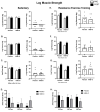Small-Scale Randomized Controlled Trial to Explore the Impact of β-Hydroxy-β-Methylbutyrate Plus Vitamin D3 on Skeletal Muscle Health in Middle Aged Women
- PMID: 36364934
- PMCID: PMC9658601
- DOI: 10.3390/nu14214674
Small-Scale Randomized Controlled Trial to Explore the Impact of β-Hydroxy-β-Methylbutyrate Plus Vitamin D3 on Skeletal Muscle Health in Middle Aged Women
Abstract
β-Hydroxy-β-methylbutyrate (HMB), a leucine metabolite, can increase skeletal muscle size and function. However, HMB may be less effective at improving muscle function in people with insufficient Vitamin D3 (25-OH-D < 30 ng/mL) which is common in middle-aged and older adults. Therefore, we tested the hypothesis that combining HMB plus Vitamin D3 (HMB + D) supplementation would improve skeletal muscle size, composition, and function in middle-aged women. In a double-blinded fashion, women (53 ± 1 yrs, 26 ± 1 kg/m2, n = 43) were randomized to take placebo or HMB + D (3 g Calcium HMB + 2000 IU D per day) during 12 weeks of sedentary behavior (SED) or resistance exercise training (RET). On average, participants entered the study Vitamin D3 insufficient while HMB + D increased 25-OH-D to sufficient levels after 8 and 12 weeks. In SED, HMB + D prevented the loss of arm lean mass observed with placebo. HMB + D increased muscle volume and decreased intermuscular adipose tissue (IMAT) volume in the thigh compared to placebo but did not change muscle function. In RET, 12-weeks of HMB + D decreased IMAT compared to placebo but did not influence the increase in skeletal muscle volume or function. In summary, HMB + D decreased IMAT independent of exercise status and may prevent the loss or increase muscle size in a small cohort of sedentary middle-aged women. These results lend support to conduct a longer duration study with greater sample size to determine the validity of the observed positive effects of HMB + D on IMAT and skeletal muscle in a small cohort of middle-aged women.
Keywords: hypertrophy; intermuscular adipose tissue (IMAT); resistance exercise; sarcopenia.
Conflict of interest statement
J.A.R. is a current employee and L.M.P. is a former employee of MTI BioTech which has a partnership with TSI USA, LLC. TSI markets HMB. J.A.R. and L.M.P. are co-inventors on several HMB-related patents. J.A.R. and L.M.P. were not involved in data collection, randomization, or final analysis and remained blinded to study groups like the rest of the investigative team.
Figures






References
-
- Delmonico M.J., Harris T.B., Visser M., Park S.W., Conroy M.B., Velasquez-Mieyer P., Boudreau R., Manini T.M., Nevitt M., Newman A.B., et al. Longitudinal Study of Muscle Strength, Quality, and Adipose Tissue Infiltration. Am. J. Clin. Nutr. 2009;90:1579–1585. doi: 10.3945/ajcn.2009.28047. - DOI - PMC - PubMed
-
- Buford T.W., Lott D.J., Marzetti E., Wohlgemuth S.E., Vandenborne K., Pahor M., Leeuwenburgh C., Manini T.M. Age-Related Differences in Lower Extremity Tissue Compartments and Associations with Physical Function in Older Adults. Exp. Gerontol. 2012;47:38–44. doi: 10.1016/j.exger.2011.10.001. - DOI - PMC - PubMed
-
- Goodpaster B.H., Chomentowski P., Ward B.K., Rossi A., Glynn N.W., Delmonico M.J., Kritchevsky S.B., Pahor M., Newman A.B. Effects of Physical Activity on Strength and Skeletal Muscle Fat Infiltration in Older Adults: A Randomized Controlled Trial. J. Appl. Physiol. 2008;105:1498–1503. doi: 10.1152/japplphysiol.90425.2008. - DOI - PMC - PubMed
Publication types
MeSH terms
Substances
Grants and funding
LinkOut - more resources
Full Text Sources

